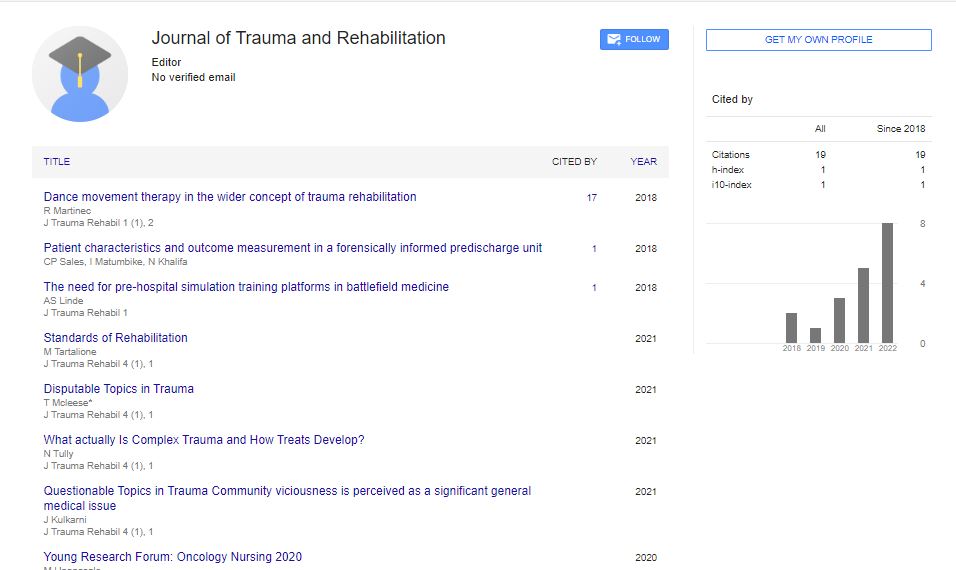Perspective, J Trauma Rehabil Vol: 6 Issue: 2
Implementing Advanced Techniques in Rehabilitation
Sofia Garcia*
1Department of Trauma and Emergency Medicine, University of Sao Paulo, Sao Paulo, Brazil
*Corresponding Author:Sofia Garcia,
Department of Trauma and Emergency
Medicine, University of Sao Paulo, Sao Paulo, Brazil
E-mail: sofia.garcia@gmail.com
Received date: 29 May, 2023, Manuscript No. JTR-23-106888;
Editor assigned date: 31 May, 2023, PreQC No. JTR-23-106888 (PQ);
Reviewed date: 14 June, 2023, QC No. JTR-23-106888;
Revised date: 21 June, 2023, Manuscript No. JTR-23-106888 (R);
Published date: 28 June, 2023, DOI: 10.4172/Jtr.1000127
Citation: Garcia S (2023) Implementing Advanced Techniques in Rehabilitation. J Trauma Rehabil 6:2.
Description
Rehabilitation is an integral part of the healing process for individuals recovering from injuries, surgeries, or medical conditions. Over the years, advancements in medical studies and technology have led to the development of innovative and advanced rehabilitation techniques. These cutting-edge approaches are grounded in scientific evidence and aim to optimize the recovery and functional outcomes for patients.
Advancements in rehabilitation science
The journey of implementing advanced techniques in rehabilitation starts with scientific studies and discoveries. Rehabilitation science is a multidisciplinary field that encompasses areas such as physiotherapy, occupational therapy, speech therapy, and kinesiology. Investigators continuously investigate the underlying mechanisms of recovery and explore novel interventions to enhance rehabilitation outcomes.
Neuroplasticity: Understanding the brain's capacity to reorganize and adapt after injury or trauma has paved the way for neuroplasticitybased interventions. These techniques aim to promote neural rewiring and functional recovery.
Robotics and exoskeletons: Advancements in robotics and wearable exoskeletons have enabled therapists to provide targeted and intensive training to patients with neurological or musculoskeletal conditions, improving mobility and motor function.
Virtual Reality (VR) and Augmented Reality (AR): VR and AR technologies offer immersive rehabilitation experiences, allowing patients to engage in therapeutic activities and simulations to regain functional skills and confidence.
Brain-Computer Interfaces (BCI): Emerging brain-computer interface technologies allow individuals with severe motor impairments to control external devices using their brain signals, promoting independence and communication.
Evidence-based practice
The translation of rehabilitation science into clinical practice is driven by the principles of evidence-based medicine. Rigorous clinical trials and studies studies are conducted to assess the effectiveness and safety of advanced rehabilitation techniques. Evidence-based practice ensures that interventions are well-supported by scientific evidence before they are incorporated into clinical care.
Randomized Controlled Trials (RCTs): RCTs are the gold standard for assessing the efficacy of new rehabilitation techniques. They involve comparing the outcomes of patients receiving the new intervention to those receiving standard care or a placebo.
Systematic reviews and meta-analyses: These comprehensive analyses of multiple studies provide a high level of evidence, helping clinicians make informed decisions about the adoption of new techniques.
Clinical guidelines: Leading rehabilitation organizations and professional bodies develop clinical practice guidelines based on the best available evidence. These guidelines offer clinicians standardized approaches to incorporating advanced techniques into their practices.
Integration into clinical settings
Once the scientific evidence establishes the efficacy of advanced rehabilitation techniques, the process of integrating them into clinical settings begins. This integration involves several critical steps:
Training and education: Rehabilitation professionals need specialized training to effectively use advanced techniques. Workshops, seminars, and certifications ensure that clinicians have the necessary skills and knowledge.
Equipment and infrastructure: The implementation of certain advanced techniques may require specialized equipment and technology. Healthcare facilities must invest in appropriate resources to deliver these interventions.
Interdisciplinary collaboration: Advanced rehabilitation techniques often involve collaboration between various healthcare disciplines. A cohesive team approach ensures comprehensive patient care.
Patient-centered care: Individualized treatment plans are essential for effective rehabilitation. Advanced techniques are tailored to each patient's unique needs and goals.
Real-world impact on patient care
The integration of advanced rehabilitation techniques into clinical practice has a profound impact on patient care:
Improved functional outcomes: By employing evidence-based and targeted interventions, patients experience enhanced functional recovery and greater independence.
Faster recovery: Advanced techniques facilitate more efficient and accelerated rehabilitation, shortening the length of hospital stays and reducing healthcare costs.
Enhanced patient experience: The incorporation of innovative technologies, such as virtual reality, engages and motivates patients during their rehabilitation journey.
Long-term benefits: Many advanced techniques promote longterm gains and continued progress beyond the completion of formal rehabilitation.
The future of rehabilitation medicine
The successful implementation of advanced rehabilitation techniques signals an exciting future for rehabilitation medicine:
Personalized medicine: Advancements in technology and the use of data analytics will allow for increasingly personalized and precision-based rehabilitation plans.
Tele-rehabilitation: Telehealth and tele-rehabilitation platforms will expand access to advanced techniques, particularly for patients in remote or underserved areas.
Artificial intelligence: AI-driven technologies will assist therapists in analyzing patient data, predicting recovery trajectories, and tailoring interventions for optimal results.
Conclusion
The journey from science to practice in implementing advanced rehabilitation techniques showcases the transformative potential of evidence-based medicine. As investigaters continue to uncover new insights and technologies, rehabilitation medicine will witness ongoing innovation, benefiting patients' recovery and quality of life. By embracing evidence-based practice, investing in training and technology, and fostering interdisciplinary collaboration, rehabilitation professionals can shape the future of patient care, paving the way for a more inclusive and effective rehabilitation journey for individuals worldwide.
 Spanish
Spanish  Chinese
Chinese  Russian
Russian  German
German  French
French  Japanese
Japanese  Portuguese
Portuguese  Hindi
Hindi 